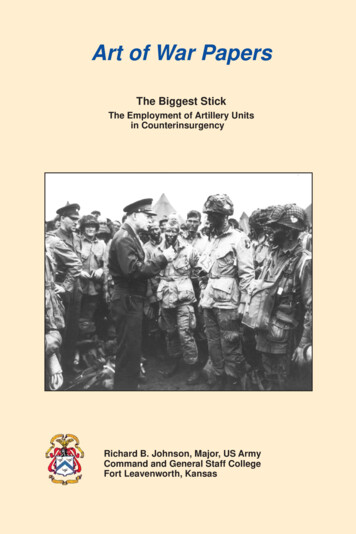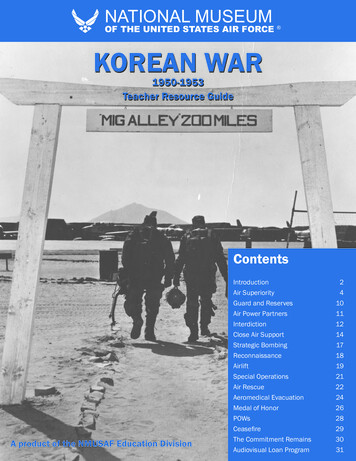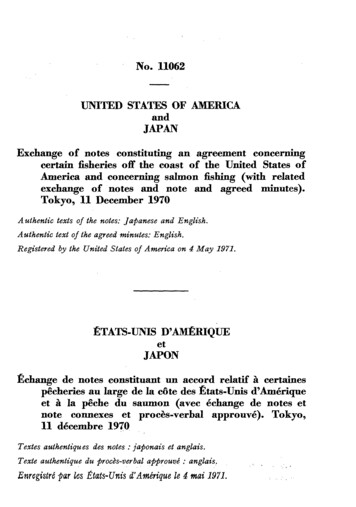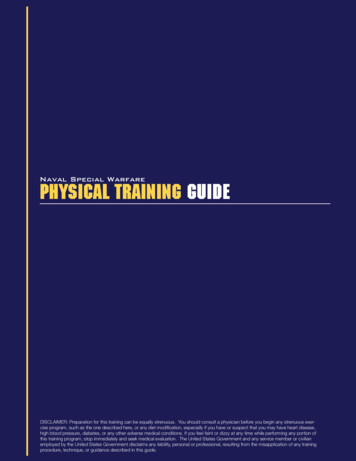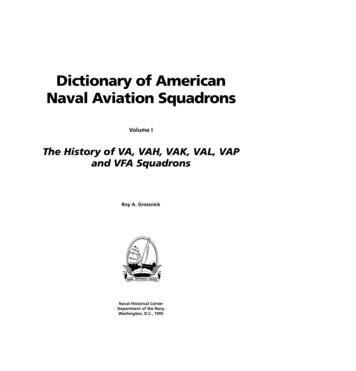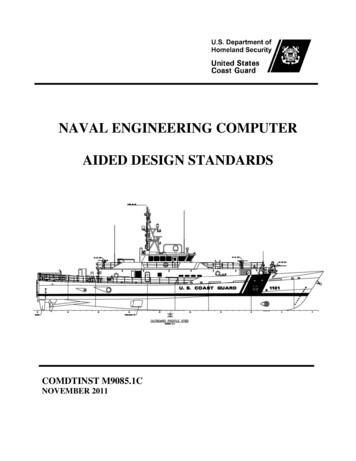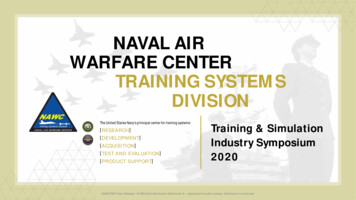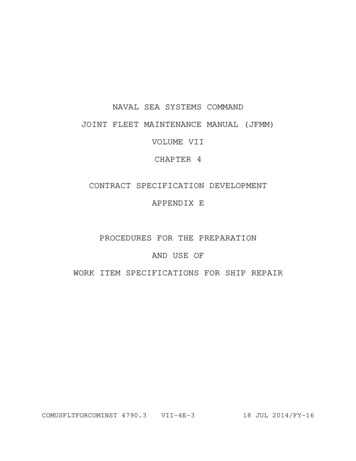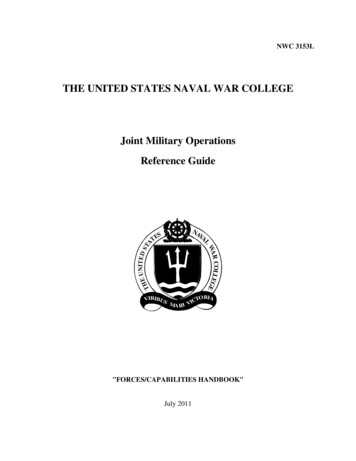
Transcription
NWC 3153LTHE UNITED STATES NAVAL WAR COLLEGEJoint Military OperationsNAVASTELETHU NI T E D SR COLLEGEWATAReference GuideORIAVIRIBUSCTMA RI VI"FORCES/CAPABILITIES HANDBOOK"July 2011
INTENTIONALLYLEFTBLANK
TABLE OF CONTENTSPageIntroduction . 1U.S. NavyIIIIIIIVVVI. 2Mission and Purpose . 2Organization and Command Structure . 2US Navy Concept of Operations . 7Capabilities . 14Navy Reserve . 27Current Challenges . 28U.S. ArmyIIIIIIIVVVIVIIVIIIIX. 30Introduction. 30Operating Structure . 32Army Organization . 33Army Commands . 39Army National Guard and Army Reserve . 57Army Logistical Data . 58Major Army Systems . 61Army Coordination Issues . 67References. 69U.S. Marine Corps . 71IMission and Purpose . 71IIOrganization and Structure . 72III Marine Air Ground Task Force (MAGTF) . 74IV Warfighting Doctrine . 81VSystems and Equipment . 81VI Service Specific Issues . 82U.S. Air Force . 84IAir Force Vision. . 84IIAir Force Mission. . 84III Command Structure . 84IV Major Command Structure. . 86VAir National Guard . 104VI The Air and Space Expeditionary Force . 107VII Aircraft Capabilities . 108VIII Space Capabilities . 115U.S. Coast Guard . 117IOrganization . 117IIConcept of Operations . 117III General Information. 122IV Coast Guard Forces. 123
Special Operations Forces. 133IMission . 133IISOCOM Vision . 133III Organization . 134IV Concept of Operations . 138VGeneral Information. 140Strategic Lift . 148IMission, Organization, and Resources . 148IIConcept of Operations for Strategic Deployment . 161III Movement in Support of Homeland Defense and Civil Support . 163Operational Command and Control . 164IIntroduction. 164IICommand Relationships and Levels of Authority. 165III Joint Command Organization . 169IV Multinational Command Organization. . 178VUS vs. Alliance Command Relationships . 182Appendix A — Services' Insignia . A-1Appendix B — Conversion Table. B-1Appendix C — Navy Composite Warfare Commander (CWC) Concept . C-1Appendix D — Air and Sea Route Times . D-1
INTRODUCTIONEvery student enrolled at the Naval War College is presumed to have a solidunderstanding and appreciation of their service's capabilities and limitations, particularly withintheir occupational specialty. However, knowledge of the other services' combat organizations,doctrine, concept of operations, or general information (and perhaps that of other occupationalspecialties within your own service) is likely to be less comprehensive. This document providesbasic information about each of the services, SOF, strategic lift, and operational command andcontrol. Each of these topics will be discussed in greater detail in future sessions.The format of this document is designed to be succinct yet also present a complete andaccurate description of the subject. Short paragraphs, bullet format, diagrams and appendices areused to convey general or generic, vice specific, information. Numbers, ranges, sizes and speedsare either rounded off, cover a broad range of options, or are not discussed at all. The goal is foryou to become familiar with the capabilities that the joint force can provide so that you, theoperational planner, can accomplish your mission objectives. This document can also serve as aquick reference in your future endeavors.Finally, in this ever-changing defense environment of budget restraints, base closures, andforce reductions, some of the information contained within may be or become outdated. Seminardiscussions will address the most current information.1
U.S. NAVYI. Mission and PurposeThe mission of the Navy is to maintain, train and equip combat-ready Naval forces capableof winning wars, deterring aggression and maintaining freedom of the seas. In order tosuccessfully carry out this broad mission the Navy maintains capability to perform thefollowing key functions as directed by DOD Directive 5100.01: Conduct offensive and defensive operations associated with the maritime domainincluding achieving and maintaining sea control, to include subsurface, surface, land,air, space, and cyberspace. Provide power projection through sea-based global strike, to include nuclear andconventional capabilities; interdiction and interception capabilities; maritime and/orlittoral fires, to include naval surface fires; and close air support for ground forces. Conduct ballistic missile defense. Conduct ocean, hydro, and river survey and reconstruction. Conduct riverine operations. Establish, maintain, and defend sea bases in support of naval, amphibious, land, air,or other joint operations as directed. Provide naval expeditionary logistics to enhance the deployment, sustainment, andredeployment of naval forces and other forces operating within the maritime domain,to include joint sea bases, and provide sea transport for the Armed Forces other thanthat which is organic to the individual Military Services and USSOCOM. Provide support for joint space operations to enhance naval operations, incoordination with the other Military Services, Combatant Commands, and USGdepartments and agencies. Conduct nuclear operations in support of strategic deterrence, to include providingand maintaining nuclear surety and capabilities.II. Organization and Command StructureThe U.S. Navy was founded on 13 October 1775 and the Department of the Navy wasestablished on 30 April 1798. The Department of the Navy has three principal components:the Navy Department, consisting of executive offices mostly in Washington, D.C., theoperating forces, including the Marine Corps, the reserve components, and in time of war, theU.S. Coast Guard (in peace it is a component of the Department of Homeland Security), and2
the shore establishment. The focus of this chapter is on the Navy operating forces, not toinclude the Marine Corps who are addressed in a separate chapter.Naval Operating Forces (Fleet Forces)Navy operating forces have a dual chain of command. Administratively, they report to theChief of Naval Operations for the execution of their Title 10 responsibilities (man, train,equip, maintain). All Navy operating units have an administrative chain of command whichruns through the appropriate Type Commander (TYCOM): (Surface Forces (SURFOR), AirForces (AIRFOR), Submarine Forces (SUBFOR), Special Warfare (NAVSPECWARCOM),Expeditionary Forces (Navy Expeditionary Combat Command (NECC)), Auxiliary andsealift forces (Military Sealift Command)). Type Commanders have responsibility for thetraining and readiness of their “type” forces to include maintenance, manning, and equippingas well as the training and assignment of personnel. The following chart presents anoverview of the Title 10 / administrative organization of the Navy operating forces:US NAVY ADMIN ORGANIZATIONChief OfNaval OperationsChief of NavyReserveFleet CyberCommandNaval ForcesEurope/AfricaNavy Staff(OPNAV)Fleet ForcesCommandPacific FleetNaval ForcesCentralCommanderNavy InstallationsCommandBureau ofPersonnelNaval SpecialWarfareCommandNaval ForcesSouthOperationally, Navy forces report to the appropriate Unified Combatant Commandersthrough the assigned Navy component commander. As Navy units enter the area ofresponsibility (AOR) for a Geographic Combatant Commander, they fall under operationalcontrol (OPCON) of the appropriate numbered fleet commander (via the Navy component3
commander). The following chart presents an overview of the operational organization ofthe Navy operating forces:OPERATIONAL ORGANIZATIONUSEUCOM &USAFRICOMUS NavalForcesEurope/Africa6thFleetUSUSNORTHCOMFleet ForcesCommand(Atlantic Fleet)USFFDCOM COMUSCYBERCOMNaval SpecialWarfareCommandFleet ForcesCommand(Atlantic Fleet)FLTCYBERCOM/10th Fleet7thFleetUSCENTCOMUSSOUTHCOMUS NavalForces CentralCommandUS NavalForces SouthernCommand5thFleetUSSTRATCOMFleet ForcesCommand(Atlantic l Shore ForcesThe shore establishment provides support to the operating forces (known as "the fleet") in theform of: facilities for the repair of machinery and electronics; communications centers;training areas and simulators; ship and aircraft repair; intelligence and meteorologicalsupport; storage areas for repair parts, fuel, and munitions, and medical / dental facilities.The following chart illustrates the Navy shore establishment:4
Operational OrganizationThe operational level of command for Navy forces is the Numbered Fleet commander. Alloperational units operate under the OPCON of the numbered fleet commander within whosearea of operations they are located. The below table identifies the numbered fleets and theirareas of operations:FleetUSFFDCOM forFleet andJointOperations*3rd4th5thHeadquarteredArea of operationsNorfolk, VAWestern Atlantic OceanSan Diego, CAMayport, FLManama, BahrainEastern and Central Pacific OceanCaribbean, Central and South AmericaMiddle East (Red Sea, Arabian Sea, Arabian Gulf)Eastern Atlantic Ocean, Southern Indian Ocean6thNaples, Italyadjacent to Africa, Mediterranean, Adriatic, Baltic,Barents, Black, Caspian, North Seas.7thYokosuka, JapanWestern Pacific, Indian Oceannd* USFF combination with 2 Fleet left USFF 3 Star Deputy to run Fleet FunctionsNumbered fleet commanders are permanently organized and assigned to a geographiccombatant commander. To command forces at the operational level in the maritime domain,each numbered fleet has a Maritime Operations Center (MOC). The MOC gives the fleetcommander g
The U.S. Navy was founded on 13 October 1775 and the Department of the Navy was established on 30 April 1798. The Department of the Navy has three principal components: the Navy Department, consisting of executive offices mostly in Washington, D.C., the operating forces, including the Marine Corps, the reserve components, and in time of war, the

